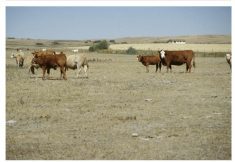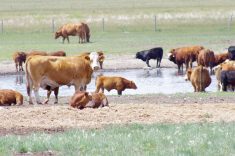What’s the forecast for Canadian ag?
How about murky with a good chance of turbulence?
‘Headwinds’ was the phrase du jour when the country’s foremost ag economist came by FarmTech late last month.

“There are lots of good things going on in the industry, but lots of headwinds as well — trade tensions, weather, excess supply, rising borrowing costs,” said J.P. Gervais, Farm Credit Canada’s chief agricultural economist.
“The growth that we’ve seen over the last 10 years has been spectacular, but I think it’s important to be realistic about what the next 10 years are going to look like.”
Right now though, you’ve got a choice of economic indicators to choose from.
Want some optimism about the economy? The labour market is tight, unemployment rates are dropping across the country, and wages are finally growing.
Looking for reasons to worry? The oil and gas outlook is poor, unemployment will probably start to head back up soon, and “the world economy is slowing down.”
Read Also

Farming Smarter receives financial boost from Alberta government for potato research
Farming Smarter near Lethbridge got a boost to its research equipment, thanks to the Alberta government’s increase in funding for research associations.
Oh, and don’t forget household financials.
“Consumer debt is at a record high,” said Gervais. “Debt is going up, and it’s been going up faster than income for a number of years.”
And although many expect the Bank of Canada to stop hiking interest rates in the face of a slowing economy, Gervais is predicting “one, perhaps two” rate increases before year’s end. So at this point, it might not be a bad idea to lock in rates, he advised.
“That price right now is as low as it ever was,” said Gervais. “To lock in long term is very cheap as an insurance against future rate increases.”
Loonie and loans
Making the call to lock in a loan rate requires considerable thought as well as a good, hard look at cash flow.
But Gervais has some good news on the latter — he predicts the loonie will end the year at 75 U.S. cents even though it’s undervalued.
“It’s a little bit low frankly, given what we’re seeing in the marketplace,” he said. “But I still think we’re going to see a little bit more weakness in the Canadian dollar before we finish the year a little stronger.”
And in case you’re wondering what a penny is worth these days, it’s a lot.
A one-cent decline in the loonie (versus the U.S. greenback) will boost net income for the typical Canadian farmer by roughly $5 per acre.
Export-dependent farmers here can thank the falling dollar for saving them from the battering experienced by their counterparts south of the border.
“Net farm income in the U.S. has declined over almost five successive years, and the only reason we haven’t seen a decline as big in the U.S. is our Canadian dollar.”
Trade tensions
And what about Washington’s trade battle with Beijing? Will that increase Chinese demand for Canadian crops and livestock?
Not necessarily, said Gervais.
Yes, shunning American crops such as soybeans can drive up prices elsewhere — but that tends to result in buyers reducing their purchases.
The bigger prize in the U.S.-China trade dispute is the longer-term one, gaining access to new buyers in the world’s most populous market.
“I know there’s a lot of politics around China right now, but I also know that’s a big market,” said Gervais. “In China, when they have an additional dollar of income, they spend 30 cents of that dollar on food. In Canada when we have an additional dollar of income, we spend 10 cents on food, and very little of that additional 10 cents goes back to the farm.
“So that 30 cents in China is a big deal. It has an impact on what we sell.”
The revised NAFTA deal with the U.S. is also a win for farmers here even though the House of Representatives, now controlled by Democrats, is saying it wants changes before ratifying the deal (now called the United States-Mexico-Canada Agreement or USMCA).
“I know there’s a lot of skepticism right now, given the U.S.’s politics, but they’re going to have to have a win for the American people,” said Gervais.
“I think this is one of the topics they can rally around. In the meantime, we’re not losing anything, and the pricing still sends us a better signal than what we would have if we didn’t have the U.S. market open.”
But it’s the new trade deal with Trans-Pacific countries that is going to be one of Canada’s big wins for 2019, he added.
“To have the Asian markets — especially Japan — open up at a good pace is a really good thing.”
The bottom line
Gervais is expecting spring wheat acres will jump by as much as 10 per cent, durum acreage to fall by a quarter, pulse seedings to remain flat, and a small increase in barley and canola.
That’s not a mix that’s going to see incomes soar, but keep things in perspective, he said.
“Gross income at the farm level is going to be down, but there has been $500 million worth of gross income growth on an annual basis for the past 10 years,” said Gervais. “I think we tend to lose sight of that. There’s been tremendous growth.
“But the question going forward is, what kind of growth are we going to see? It’s levelling out a little bit in our forecast for 2019.”
In other words, he’s not expecting to see prices for crops and livestock go up.
“I think we’re going to have to drive revenues on the production side of things,” he said. “And unfortunately when we have issues related to weather or market access, that will create some headwinds for us.
“But as soon as we get past this, I’m confident that we’ll grow again — but maybe not at the same pace as $500 million a year for 10 years.”
Land values will also be growing at a slower rate, he added.
“We’re going to show some growth for 2018 land values in Alberta,” he said. “So land values are still going up, but that annual rate of increase is slowing down.”
But despite the mixed signals from the marketplace, Gervais expects this year to be less volatile than 2018, and his outlook is generally positive because other countries want what we’re selling.
“Right now, demand is strong, but if demand weakens because of slower economic growth or trade tensions, farmers need to be thinking about their marketing plans and changing some of their targets,” said Gervais.
“There are some headwinds, so we want to make sure we plan for them and have a good strategy in place.”















